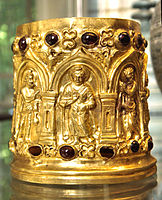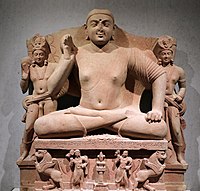Brussels Buddha
Brussels Buddha
(Inscribed "Year 5")
(Inscribed "Year 5")
Location of Gandhara
, where the Brussels Buddha was probably created.The Brussels Buddha is a famous Buddha statue from the
Sahri Bahlol due to its similarity with a statue from the same location, now in the Peshawar Museum.[3]
Characteristics
In this statue, the seated Buddha is attended by
Miracle at Śrāvastī".[5]
The statue is remarkable in that it is one of the rare Gandhara Buddhist statues to bear a dedication with a date.Kharoshti reads:
| Original (Kharosthi script) | Transliteration | English translation |
|---|---|---|
| 𐨯𐨎 𐩃 𐩀 𐨥𐨒𐨂𐨣𐨯𐨨𐨯𐨯 𐨡𐨁 𐨤𐨎𐨕𐨨𐨁 𐨦𐨂𐨢𐨣𐨡𐨯 𐨟𐨿𐨪𐨅𐨤𐨁𐨜𐨐𐨯 𐨡𐨣𐨨𐨂𐨑𐨅 𐨨𐨡𐨤𐨁𐨡𐨪𐨣 𐨀𐨢𐨿𐨬𐨡𐨁𐨡𐨣 𐨤𐨂𐨩𐨩 𐨧𐨬𐨟𐨂 | saṃ 4 1 Phagunasamasasa di paṃcami Budhansadasa trepiḍakasa danamukhe madapidarana adhvadidana puyaya bhavatu | In the year 5, in the 5th day of the month Phalguna: the pious gift of the Monk Buddhananda, learned in the Tripiṭaka: may it be for the honouring of his deceased (?) mother and father. |
The date "Year 5" should normally refer to the
Khingila, which would give a period circa the 5th century CE, but such a date can be considered as too late.[4][1] A date in the Gupta era has also been suggested, but there is no evidence of the Gupta era being used so far north.[7]
According to
Kanishka I, as the shapes of several letters are typical of that period.[3] The language of the inscription is a mix of Prakrit and Sanskrit.[3] This dated sculpture suggests that the Greco-Buddhist art of Gandhara was already at a very advanced stage of sophistication at the beginning of the Kushan period, in the early 2nd century CE, implying the existence of a long preliminary tradition leading up to it.[3]
Other examples
There are a few examples of similar triads in Gandhara as well as in Mathura, most dated to the early Kushans:[8][9]
-
An early standing triad withBuddha and Indra. Bimaran casket, circa 10 CE.
-
A very similar Buddhist Triad from
-
Seated Buddha triad,Sahr-i-Bahlolexcavations, 1911-1912.
-
A contemporary triad from the Art of Mathura, the Kimbell seated Bodhisattva (inscribed "Year 4 of Kanishka").
See also
- Kimbell seated Bodhisattva, a possibly contemporary Buddhist triad from Mathura
References
- ^ a b c d e f g The Classical Art Research Centre, University of Oxford (2018). Problems of Chronology in Gandhāran Art: Proceedings of the First International Workshop of the Gandhāra Connections Project, University of Oxford, 23rd-24th March, 2017. Archaeopress. p. 43–44.
- ISBN 978-90-04-18400-8.
- ^ JSTOR 43732476.
- ^ ISBN 978-90-04-19019-1.
- ^ Hargreaves, H. (1930). Handbook to the Sculptures in the Peshawar Museum. p. Plate 2.
- ^ Rhi, Juhyung. Identifying Several Visual Types of Gandharan Buddha Images. Archives of Asian Art 58 (2008). pp. 53–56.
- ISBN 978-90-04-13595-6.
- ISBN 978-90-04-18400-8.
- ^ Rhi, Juhyung. Identifying Several Visual Types of Gandharan Buddha Images. Archives of Asian Art 58 (2008). pp. 53–56.
- ^ Rhi, Juhyung. Identifying Several Visual Types of Gandharan Buddha Images. Archives of Asian Art 58 (2008). pp. 53–56.
- ^ The Classical Art Research Centre, University of Oxford (2018). Problems of Chronology in Gandhāran Art: Proceedings of the First International Workshop of the Gandhāra Connections Project, University of Oxford, 23rd-24th March, 2017. Archaeopress. p. 45, notes 28, 29.



![A very similar Buddhist Triad from Sahr-i-Bahlol.[3] Peshawar Museum.[10][11]](http://upload.wikimedia.org/wikipedia/commons/thumb/2/24/Buddhist_Triad_Peshawar_Museum.jpg/200px-Buddhist_Triad_Peshawar_Museum.jpg)

